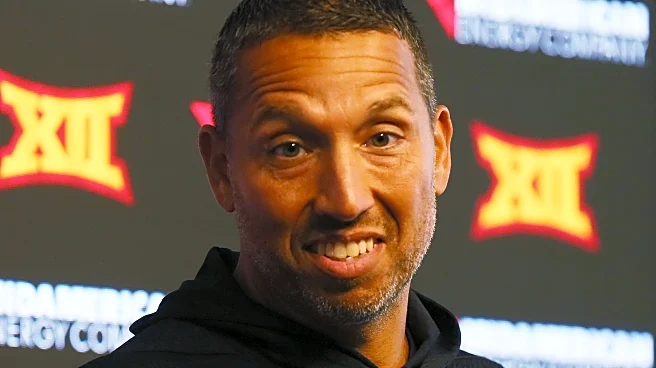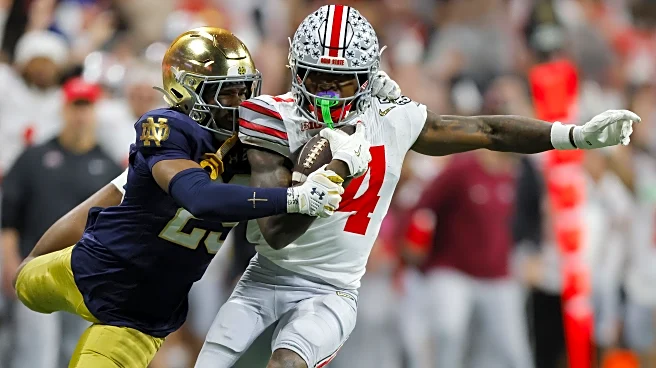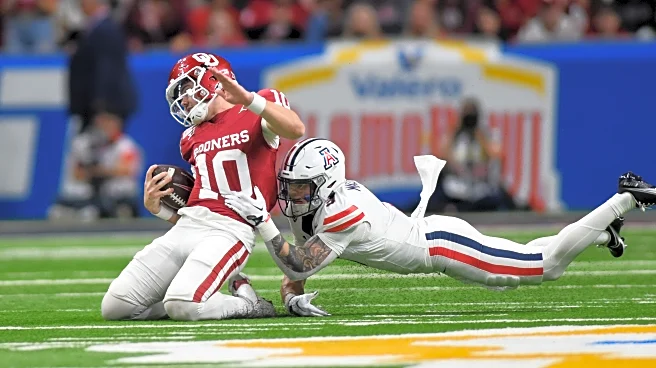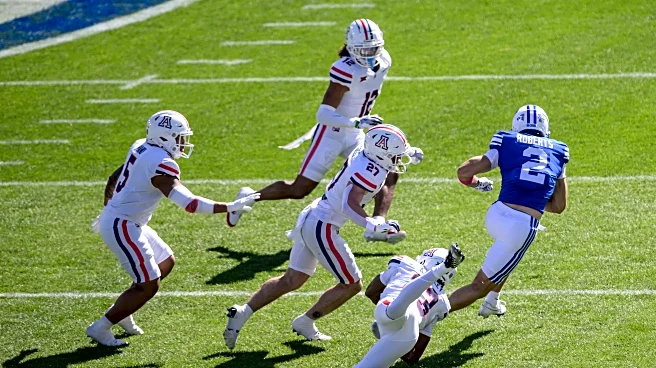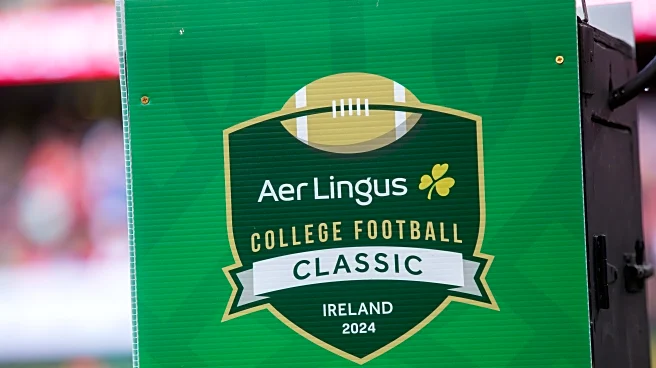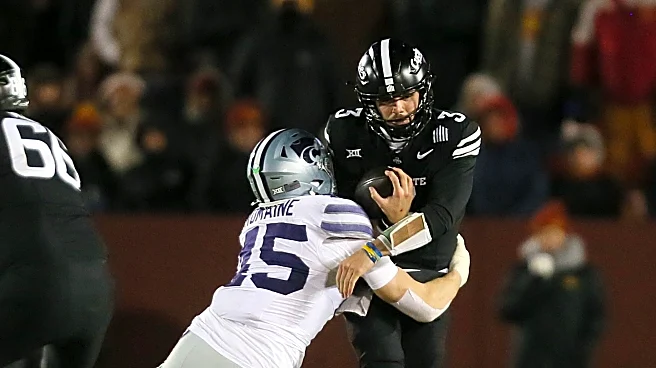
Less than 24 hours remain until the ‘Cats and Cyclones take the field, ready to do battle in Irish Farmageddon! Let’s take a look at the Iowa State depth chart and see if it reveals any deep insights into tomorrow’s game.
Quarterback
#3 – Rocco Becht: 6-1, 210, Jr.
- #7 – Alex Manske: (6-3, 225, Fr.) OR
- #5 – Connor Moberly: (6-4, 220, Fr.)
Becht is a perfectly fine quarterback most of the time and is occasionally a good quarterback. Last season, he was 271/456 (59.4%), for 3505 yards, 25 touchdowns, and 9 interceptions. He also ran the ball 98 times for 318 yards and 8 touchdowns. More
importantly, he helped lead Iowa State to an 11-3 record and a chance to play for a Big 12 title (which didn’t go so well for Iowa State).
My general assessment of Becht is that he’s a gamer. He’s not dripping talent like Avery, but last season, more often than not, when they needed him to make a play, he made a play. They beat Iowa by 1 point in the second game of the season. Iowa State was down 7-19 with 4:47 left in the 3rd, and then Becht led the Cyclones to 13 straight points, including a 54-yard game-winning field goal with 6 seconds remaining.
On the road late in the season against Utah, Iowa State looked to be on the wrong side of a comeback. The Utes were down 24-13 with 5 minutes remaining in the 3rd quarter before two consecutive touchdowns to take a 28-24 lead with 5:51 remaining. Becht promptly took Iowa State on a 10-play, 75-yard touchdown drive to retake the lead. A missed 54-yard Utah field goal later, and the Cyclones got out of town with a win.
That’s all to say, you don’t want to leave Rocco hanging in a game late. He’s one of those guys who usually figures out a way to beat you if he’s given the opportunity. That pairs well with Iowa State’s punishing run game and strong defense, which tend to keep them in most games. Even in their loss 23-22 loss to Tech, Becht led Iowa State to 10 points in the fourth quarter, giving his team a 22-17 lead with 2:11 remaining. All the dense had to do was keep Texas Tech out of the endzone, but they couldn’t finish the assignment.
Becht shines in the 3rd and 4th quarter, and no lead is safe. You either need to put them away early, like Arizona State did in their 45-19 win over the Cyclones in the Big 12 Championship game, or you need to figure out how to get your hands on the ball last and end the game with your offense on the field.

Running Back
# 26 – Carson Hansen (6-2, 220, Jr.)
- #24 – Abu Sama III: (5-11, 210, Jr.)
- #2 – Dylan Lee: (6-1, 215, Fr.) OR
- #21 – Aiden Flora (6-0, 190, Fr.)
Did I mention Iowa State’s punishing running attack, because that’s the story of the game for me. Kansas State can’t let the Cyclones’ dual-back attack consisting of starter Carson Hansen and key reserve Abu Sama. As you can see from their size listings, these are some big, strong boys Matt Campbell is bringing to this jig, and they run with an attitude.
In 2024, Hansen ran the ball 151 times for 752 yards (5 YPC) and 13 touchdowns. Sama III wasn’t far off the pace, toting the rock 124 times for 587 yards (YPC) and 2 touchdowns. Last season, K-State held Hansen in check, limiting him to 4.5 a carry on 13 touches, but Sama broke loose for 81 yards on 15 carries, and Becht found the endzone on the ground.
We’ve been talking about the Wildcats’ depth up front all offseason, and that has to play a factor tomorrow. I expect to see more 4-man fronts than you’ve seen out of Joe Klanderman’s crew in a while. You have to control the “A” and “B” and keep Hansen and Sama bouncing down the line instead of getting their shoulders square and attacking downhill. Tackling is sometimes spotty in opening games, and if you try to arm tackle either of these guys, they are going to make you look silly.

Tight End
#18 – Benjamin Brahmer: (6-7, 255, Jr.) OR
#84 – Gabe Burkle: (6-6, 255, Jr.)
- 87 Cooper Alexander (6-4, 245, Fr.)
Iowa State returns the same tight end tandem they featured last season. I wouldn’t consider either a major threat in the passing game. Brahmer’s best game last season was a 3-reception, 73-yard breakout against Arkansas State that was buoyed by a long reception.
Brahmer was injured on November 2nd against Texas Tech. Burkle stepped up as the primary tight end and put up better numbers than Brahmer, putting up 73 yards and 6 receptions against Cincinnati, 5 receptions for 34 yards against Arizona State, and 4 receptions for 54 yards against Miami (FL) in their bowl game.
I’m not overly concerned about either breaking out, but they’re both good enough to beat a defense deep if they get turned loose. Iowa State is going to pound the ball between the tackles a good bit. Sometimes, the tight end gets lost in the mix, and a well-timed play action pass can go for big yardage. The ‘Cats’ secondary has to maintain their discipline because it’s going to be tempting to throw as many bodies as possible at the run game, and that has led to tight ends being cut lose in the secondary on occasion.

Flanker
#82 – Tyler Moore: (6-5, 255, Sr.)
- #85 – Keaton Roskop: (6-3, 240, Fr.)
Kansas State listed two tight end positions on their depth chart. Iowa State lists a tight end and a flanker. It’s the same thing. They’ll use Moore as a blocker. Where he lines up is a decent key for where Iowa State wants to run the ball.

Wide Receiver
F – Receiver
#6 – Eli Green: (5-11, 195, Sr.) OR
#4 – Xavier Townsend: (5-11, 195, Jr.)
X-Receiver
#11 – Dominic Overby: (6-5, 200, Fr.) OR
#0 – Chase Sowell: (6-3, 210, Jr.)
Z-Receiver
#9 – Brett Eskildsen: (6-1, 200, So.) OR
#10 – Carson Brown (6-1, 200, Jr.)
- #16 – Daniel Jackson (6-2, 215, Sr.)
I’m not sure what to make of Iowa State’s wide receiver room, and from the looks of their depth chart, neither is Iowa State. Last season, Jayline Noel and Jayden Higgins were the tandem of wide receivers in the nation, both catching 80+ passes for 1000+ yards and a combined 17 touchdowns.
F- Receiver
Eli Green is going to play their “F” role (basically the slot) after pulling in 10 receptions for 115 yards last season, 4 of which came against North Dakota, but did put up 1.197 all-purpose yards as a freshman at North Dakota State before transferring to Iowa State after his freshman campaign. He’s quick with the ball in his hands and should feature in their screen game.
Xavier Townsend played in the Big 12 last season, but not for Iowa State. He put in 4 games of work at UCF, and looked good in those 4 games, hauling in 10 passes for 69 yards and a touchdown and rushing for 96 yards on 10 carries. Then he shut it down to preserve his redshirt and…gross, I hate that, but whatever, welcome to modern college football. He’s another quick receiver in the slot that they’ll look to get the ball to behind or around the line of scrimmage.
X – Receiver
These are the big guys they line up outside and throw the ball to when they end up in single coverage. That happens quite a bit with their run game.
Overby played in 4 games and then took a redshirt last season. He had 1 catch for 9 yards, but the dude is an ATHLETE. He has the state 5A record in Utah in the 100m (10.54) and the 200m (20.91), and the overall state record for long jump (23’11”). I anticipate Rocco uncorking a deep one into single coverage to Overby at least once, and possibly multiple times, if given the opportunity to throw into single coverage on the outside. The best way to prevent that from happening is for the K-State defensive line and linebackers to hold up and allow Coach Klanderman to keep his safeties deep.
Chase Sowell was their big move in the transfer portal, coming in from East Carolina, and, like Overby, will be the deep threat in the offense. In 9 games last season, he brought in 34 receptions, which doesn’t seem like a lot, until you notice that they went for 678 yards and 3 touchdowns. He didn’t catch many, but when he did catch them, they went for almost 20 yards. That’s going to be his job in this offense as well.
Z-Receiver
This set of players will typically line up on the wide side of the field with the F-Receiver. They tend to be more of the all-around receivers that can block on the outside and run intermediate routes both to the sidelines and over the middle.
Eskildsen, like Overby, is an athlete. In fact, his 10.52 100m time is better than Overby’s. He was a key special teams contributor for Iowa State last season as a freshman, playing in 13 games and starting at wide receiver in the Pop-Tarts Bowl. He’s big and fast, but he hasn’t shown much in the way of catching the ball or running with it just yet.
He’s joined by Carson Brown, who played in 14 games, including 4 starts, and brought in 11 receptions for 131 yards and a touchdown. He was a solid special teams’ contributor for them last season and is looking to step up and help fill the void left by their two departed stars.

Offensive Line
Left Tackle
#75 – James Neal III: (6-6, 325, Sr.)
- #50 – Tyler Maro: (6-7, 305, Sr.)
As you can see, Neal III is a massive human being. He started all 13 games at left tackle for Iowa State in 2023 before being shuffled around the line in 2024, playing in all 14 games, with 4 starts at left tackle, 2 at left guard. He’s certainly big enough, but he couldn’t stick at left tackle last season, primarily because of speed rushers eating his lunch. The Cyclones’ game plan should protect him somewhat because he’s much better moving forward in the run game than moving backwards in pass protection.
Left Guard
#70 – Trevor Buhr: (6-4, 325, So.)
- #65 – Garret Rutledge: (6-7, 315, Fr.)
Buhr played in 13 games and started the last 4 for Iowa State, including the K-State game. He’s another big, beefy boy who wants to line up and punish the player across from him.
Center
#61 – Dylan Barrett (6-5, 325, Sr.) OR
#51 – Brendan Black (6-4, 320, Jr.) OR
#63 – Jim Bonifas (6-5, 320, Sr.)
Rest assured, someone is going to snap the ball for Iowa State tomorrow. It’s an integral part of the game, but they’re not exactly sure who that will be yet. That seems less than ideal from an Iowa State perspective.
Barrett was a reserve at Indiana who appeared in 5 games last season.
Black is the most experienced option with 20 starts on his resume over the last 2 seasons, but all of those starts came at right guard.
Bonifas started 13 games at center for Iowa State in 2023 before being demoted to the bench in 2024 where he appeared in 10 games but didn’t have a start.
I think they would prefer Bonifas to start with Black at left guard and Barrett as the backup at both spots, but that’s purely speculation on my part.
Right Guard
#51 – Brendan Black: (6-4, 320, Jr.) OR
#61 – Dylan Barrett: (6-5, 325, Sr.)
- #54 – Vaea Ikakoula: (6-3, 355, Fr.)
I guess that if Black starts at center, Barrett starts at right guard. If Barrett starts at center, Black plays right guard, and if Bonifas starts at center, Black starts at right guard.
You got that? I’m not sure I do, but we’ll keep moving.
Right Tackle
#66 – Tyler Miller: (6-9, 335, Sr.)
- #72 – Austin Barrett: (6-6, 320, So.)
Miller is a monster. He’s started 37 games (10 at left tackle as a freshman and 27 as a right tackle). When the Cyclones’ need the tough yards, look for them to get behind #66 and let him lead the way.

What’s All This Mean?
The strength of Iowa State last season was their passing game. The strength of Iowa State this season will be their run game. The line is massive, the backs are big, tough runners, and Becht can move around a little and create with his legs as well.
Their wide receivers look the part, but they haven’t done much of note on the collegiate level. They look like a group that should get better as the season progresses but may struggle early because of inexperience. I look for them to lean heavily on the more experienced side of the “or” equation in this game.
Basically, this looks like a team set up to pound the ball between the tackles, eat clock, and then try and hit an occasional deep shot once the defense gets nosy around the line of scrimmage off play action or some sort of pump-and-go route.
The game plan isn’t complicated. Stop the run and make Iowa State pass the ball to pick up first downs. That said, it’s going to be tough to stop Iowa State from running the ball. If Iowa State controls the line of scrimmage, grinds out first downs, and lets Becht create occasional magic, they’re going to be tough to beat. If Iowa State struggles to run the ball, they’re going to struggle to win games through the air, at least early, with their new group of receivers.
Like most games, this thing will be decided in the trenches.
